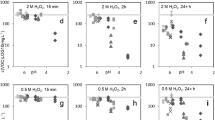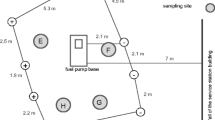Abstract
In 1997, total petroleum hydrocarbon (TPH) remediation started at a former Air Force Base, which operated from 1940 to 1991. TPH had been released to soil and groundwater at the site by military activities. The TPH was 70% jet fuel and the affected area covered 28 ha. Remediation involved a combination of technologies, including removal of volatile organic compounds using soil vapor extraction and air sparging, free product vacuum recovery and aerobic biodegradation of organics with oxygen supplied by the air sparging system, along with nutrient addition. The primary remedial method was found to be biodegradation, which has removed 93% of the contaminants from the site to date. A significant aspect of the remedial action was performance monitoring, including documentation of remediation efficiency. The goal of the research was to assess the relative accuracy of methods commonly used for monitoring in situ TPH remediation. Two such methods were selected for the research: monitoring change in soil TPH concentration (specified as non-polar extractable substances) and monitoring respiration activity in soil with a subsequent stoichiometric mass balance to estimate the mass of TPH destroyed. The study demonstrated that both of the methods provided comparable results regarding the effectiveness of in situ TPH remediation, despite the fact that their methodologies are very different.











Similar content being viewed by others
References
Anderson, W. C. (1995). Vacuum vapor extraction. US EPA 542-B-94-002.
Boulding, J. R. (1995). Practical handbook of soil, vadose zone and groundwater contamination assessment, prevention and remediation. Boca Raton, FL: CRC Press.
Downey, C. D., Hinchee, E. H., & Miller, R. N. (1999). Cost-effective remediation and closure of petroleum-contaminated sites. Columbus, OH: Battelle.
Hall, J. F., & Ratz, J. W. (1997). Extended Bioventing Testing Results for Closed Waste POL Pit, SWMU 14 Fort Rucker, AL, Parsons Engineering Science for AFCEE.
Hall, J. F., & Ratz, J. W. (1998). Two-year soil gas sampling and respiration testing results report for full-scale bioventing at the POL yard, Sites SS-06 and ST-40, Wurtsmith AFB, Michigan, Parsons Engineering Science for AFCEE.
Havranek, T. (1993). Stastika pro biologicke a lekarske vedy (Statistics for biological and medical sciences) Academia.
Hercik, F., et al (2001). Etapova zprava sanace ekologicke zateze na lokalite Hradcany. IV. etapa, (Periodical Report on Remediation of the Hradcany Site, Period VI.) KAP, Praha.
Hercik, F., et al (2002). Etapova zprava sanace ekologicke zateze na lokalite Hradcany, VI. etapa, (Periodical Report on Remediation of the Hradcany Site, Period VI.) KAP, Praha.
Hercik, F., et al (2006). Etapova zprava sanace ekologicke zateze na lokalitě Hradcany. X. etapa, (Periodical Report on Remediation of the Hradcany Site, Period X.). Earth Tech CZ: Praha.
Johnson, P. C., et al. (2001). Advances in in situ air sparging/biosparging. Bioremediation Journal, 5(4), 251–266.
Landa, I. (2000). Aktualizace analyzy rizika lokality Ralsko-letiste Hradcany, (Actualization of Risk Assesment of the Hradcany Site). Ecoland, Praha.
Leeson, A., & Hinchee, R. (1997). Soil bioventing, principles and practice. Boca Raton, FL: Lewis Publisher.
Leeson, A., Johnson, P. C., Johnson, R. L., Hinchee, R. E., & McWhorter, D. B. (1999). Air sparging design paradigm, draft. Columbus, OH: Battelle.
Machackova, J., Hercik, F., & Proksova, S. (2005). In situ bioremediation of jet fuel at the former Soviet Hradčany AFB, Proceedings of the Eight International in situ and on site Bioremediation Symposium, Baltimore USA, Battelle Memorial Institute.
Masak, J., Machackova, J., Siglova, M., Cejkova, A., & Jirku, V. (2003). Capacity of the bioremediation technology for clean-up of soil and groundwater contaminated with petroleum hydrocarbons. Journal of Environmental Science and Health, 38(10), 2447–2452.
Lee, J.-Y., Lee, C.-H., Lee, K.-K., & Choi, S.-II. (2001). Evaluation of soil vapor extraction and bioventing for a petroleum-contaminated shallow aquifer in Korea. Soil and Sediment Contamination, 10(4), 439–458.
Pitter, P. (1990). Hydrochemie, (Hydrochemistry) SNTL.
Van De Steene, J., Van Vooren, H., & Verplancke, H. (2007). Evaluation of a quasi-steady-state respiration test in a full-scale biopile,. Water Air & Soil Pollution, 183(1–4), 403–413.
Wittlingerova, Z., & Landa, I. (2003). Effect of fly ash on groundwater quality CO-MA-TECH Trnava 2003. 1194–1202.
Acknowledgements
The remediation project was funded by the Czech state budget under control of The Czech Ministry of Environment. Scientific research was performed within the EU Sixth Framework Program, priority 6. Project nr. 003998, BIOTOOL.
We thank to project managers of the clean-up project Stanislava Proksova and Ferdinand Hercik for participation in soil data evaluation and soil sampling methods development and to the team performing field measurements and soil sampling under supervision of Ales Fadrhons. Especially we thank to Jan Vitecek for providing of maps and other graphics. All people mentioned above are employees of Earth Tech CZ. Further we thank to William DiGiuseppi, James Hatton and Matthew Booth, who are employed in EarthTech USA, for reviewing and commenting on the paper.
Author information
Authors and Affiliations
Corresponding author
Rights and permissions
About this article
Cite this article
Machackova, J., Wittlingerova, Z., Vlk, K. et al. Comparison of Two Methods for Assessment of In Situ Jet-fuel Remediation Efficiency. Water Air Soil Pollut 187, 181–194 (2008). https://doi.org/10.1007/s11270-007-9507-9
Received:
Accepted:
Published:
Issue Date:
DOI: https://doi.org/10.1007/s11270-007-9507-9




